SS Finland Archival Collection
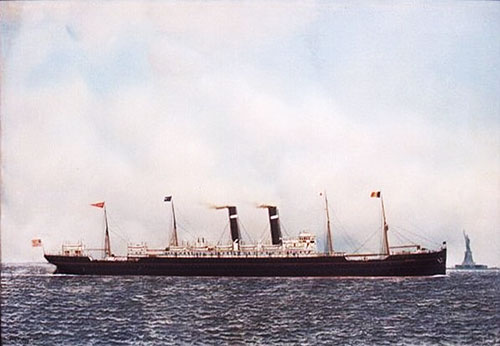
American Red Star Line Ocean Liner SS Finland in New York Harbor off the Statue of Liberty 1906, Starting Its Transatlantic Voyage to Antwerp (Belgium). The Flag on the Main Mast Is the Shipping Company's House Flag (Red Star Line New York), While There Is the Belgium Flag on the Fore Mast, Which Indicates That This American Liner Is Heading for Antwerp. Photo by A. Jacobsen 1906. | GGA Image ID # 1db0e04037
SS Finland Content Links
- Finland (1902) Red Star Line Ship's History (Brief)
- Passenger Lists
- Sailing Schedules
- Photographs
- Postcards
- Another American Built Steamship for the Red Star Line
- 1912 Summer Olympics and the SS Finland
- Finland torpedoed - 1921
Finland (1902) Red Star Line
Built by Wm. Cramp & Sons, Shipbuilding & Engineering Co., Philadelphia, Pa. Tonnage: 12,188. Dimensions: 560' X 60' (580' o.l.). Twin-screw, 16 knots. Triple expansion engines. Four masts and two funnels. Service : Antwerp-New York. Also served in American Line service. Passengers: 342 first-class, 194 second-class, and 626 third-class. Post-War Passengers: After refurbishment, she was outfitted for 242 first-class, 310 second-class, and 876 third-class passengers. Transferred to Panama-Pacific Line late in 1923. Fate: Scrapped in 1928 by Hughes Bolckow Shipbreaking Ltd at Blyth, Northumberland. She arrived for breaking on 28 April 1928. Sister ships: Kroonland, Vaderland and Zeeland. Note: In 1912, Finland was chartered by the American Olympic Committee to take the U.S. team to the 1912 Summer Olympics in Stockholm, Sweden. In 1925, Harold S. Vanderbilt devised the game of contract bridge while on board Finland.
SS Finland sailed for several subsidiary lines of International Mercantile Marine, including the Red Star Line, and also under charter for the White Star Line, the Panama Pacific Line, and the American Line.
Her routes primarily are from the port of New York to ports in the United Kingdom, Belgium, and Italy.
Passenger Lists
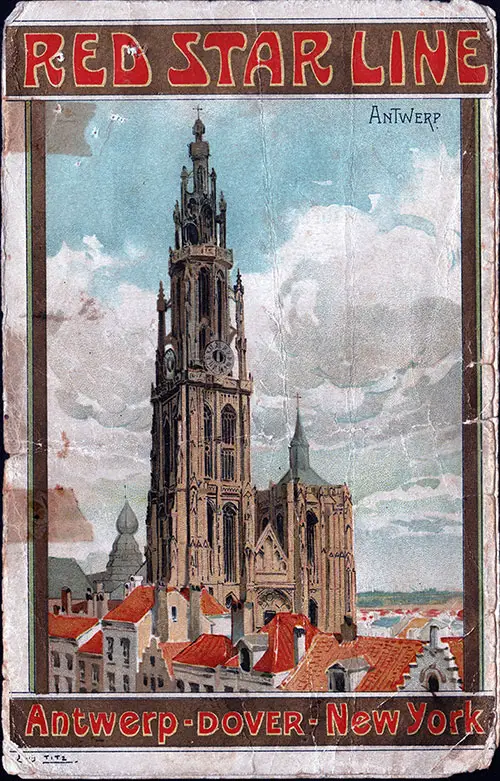
1906-05-12 SS Finland Passenger List
Cabin Passenger List for the SS Finland of the Red Star Line, Departing 12 May 1906 from Antwerp to New York via Dover, Commanded by Captain G. C. Apfeld.
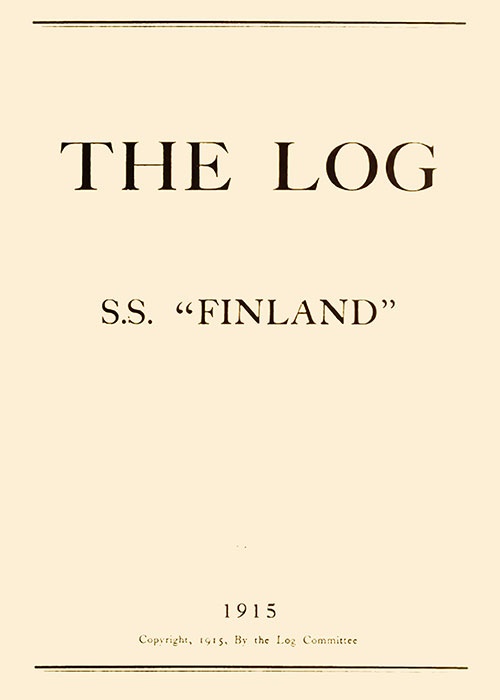
1915-07-31 SS Finland Passenger List
First Class Passenger List from the SS Finland of the Red Star Line, Chartered by the Panama-Pacific Line, Departing Saturday, 31 July 1915, from New York to San Francisco via The Panama Canal and San Diego, Commanded by Captain R. Prager.
Return to Content Links
Sailing Schedules
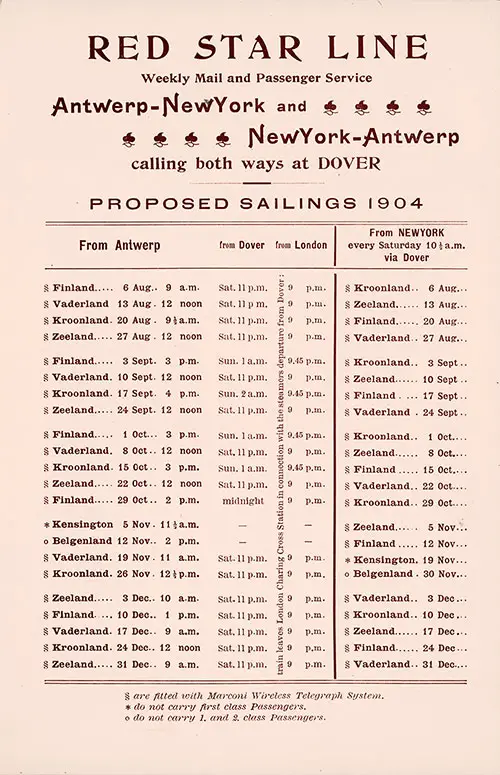
Proposed Sailings Antwerp-Dover-New York from 6 August 1904 to 31 December 1904. Ships Include the Belgenland, Finland, Kensington, Kroonland, Vaderland, and Zeeland. SS Vaderland Passenger List, 13 August 1904. | GGA Image ID # 1df144fda2
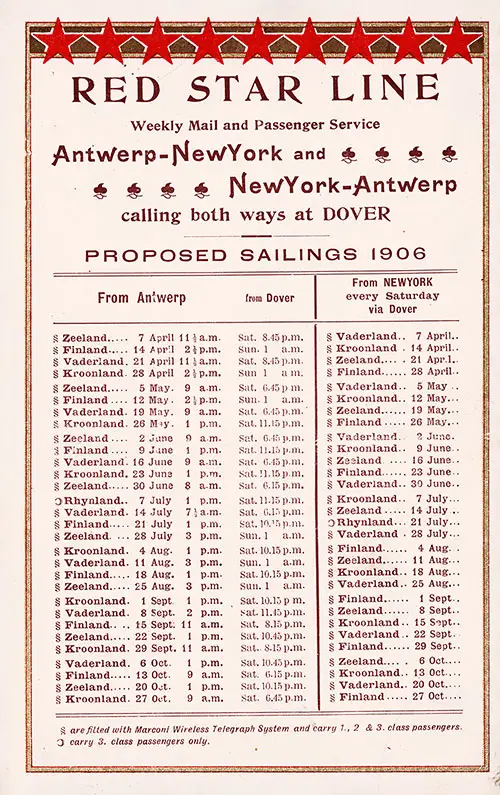
Proposed Sailings, Antwerp-Dover-New York, from 7 April 1906 to 27 October 1906. Ships Include the Finland, Kroonland, Rhynland, Vaderland, and Zeeland. SS Finland Passenger List, 12 May 1906. | GGA Image ID # 1df16fa6ef

Proposed Sailings, Antwerp-Dover-New York, from 4 April 1908 to 31 October 1908. Ships Include the Finland, Gothland, Kroonland, Vaderland, and Zeeland. SS Zeeland Passenger List, 8 August 1908. | GGA Image ID # 1df1a872b3
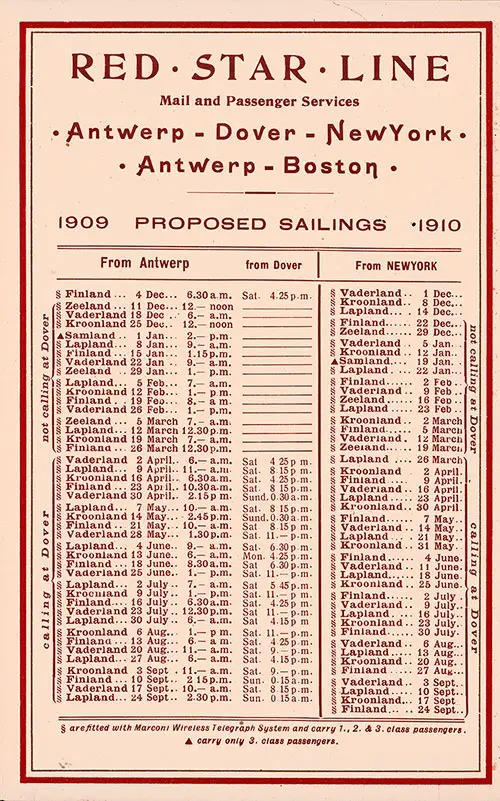
Sailing Schedule, Antwerp-Dover-New York, from 4 December 1909 to 24 September 1910. Ships Included the Finland, Kroonland, Lapland, Samland, Vaderland, and Zeeland. SS Lapland Passenger List, 27 August 1910. | GGA Image ID # 1ebde48726
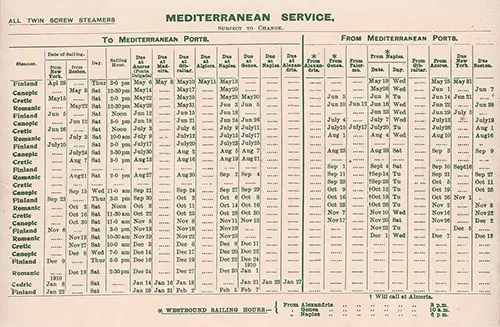
Sailing Schedule, White Star Line Mediterranean Service, from 29 April 1909 to 7 February 1910. Ships Included the Canopic, Cedric, Cretic, Finland, and Romanic. RMS Arabic Passenger List, 11 June 1909. | GGA Image ID # 1e4aacab90. Click to View Larger Image.
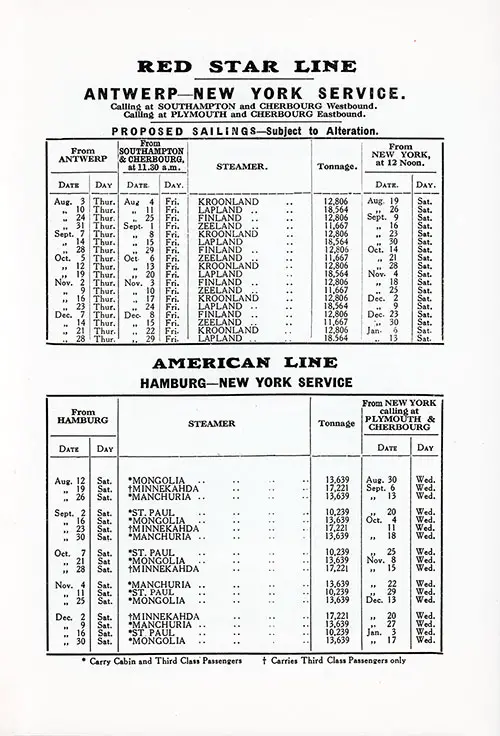
Proposed Sailings. Red Star Line: Antwerp-New York Service from 3 August 1922 to 13 January 1923. American Line: Hamburg-New York Service from 12 August 1922 to 17 January 1923. Ships Included the Red Star Line Finland, Kroonland, Lapland, and Zeeland. Ships for the American Line Manchuria, Minnekahda, Mongolia, and St. Paul. RMS Majestic Passenger List, 6 September 1922. | GGA Image ID # 1dd525c9ba
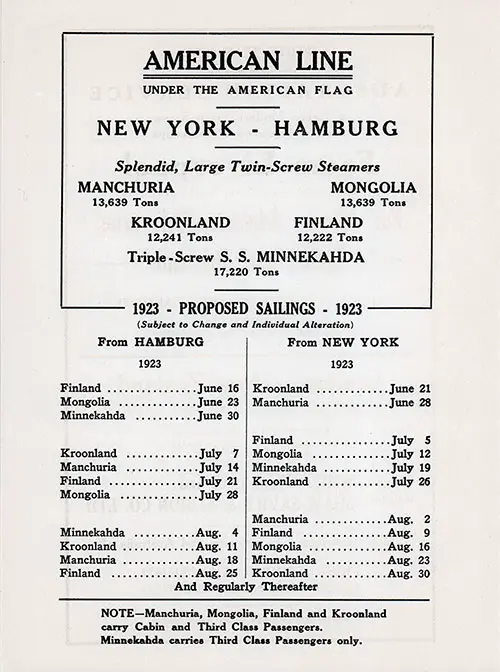
1923 Proposed Sailings from 16 June 1923 to 30 August 1923 for the American Line. Ships Listed Included the Finland, Kroonland, Manchuria, Minnekahda, and Mongolia. Note: Manchuria, Mongolia, Finland and Kroonland Carry Cabin and Third Class Passengers. Minnekahda Carries Third Class Passengers Only. SS Kroonland Passenger List, 21 June 1923. | GGA Image ID # 163142707e
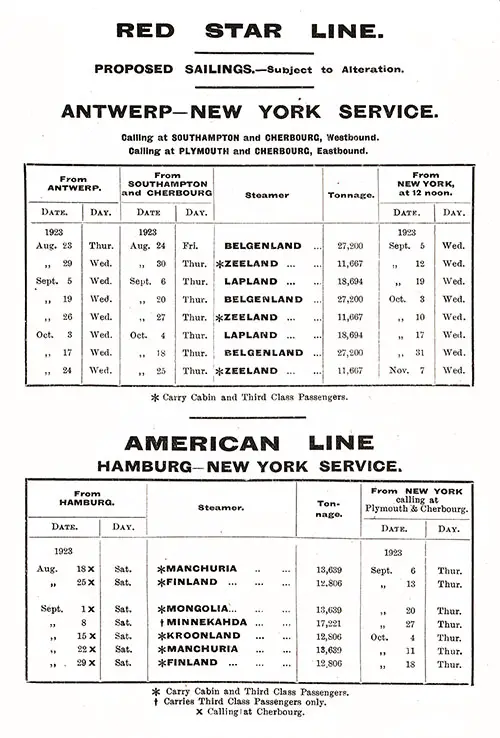
Sailing Schedule, Antwerp-Southampton-Cherbourg-New York and Hamburg-Plymouth-Cherbourg-New York, from 18 August 1923 to 7 November 1923. Ships Included the Belgenland, Finland, Lapland, Manchuria, Minnekahda, and Zeeland. RMS Homeric Passenger List, 5 September 1923. | GGA Image ID # 1f0b8ea4c9
Return to Content Links
Photographs
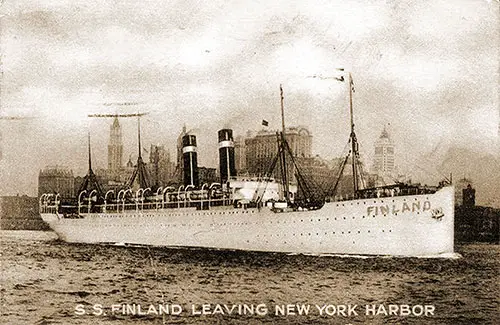
The Red Star Line SS Finland Leaving New York Harbor. Undated Postcard c 1915. | GGA Image ID # 1db10e2fbe
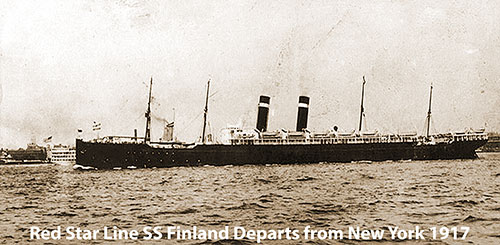
The SS Finland of the Red Star Line Departing from New York in 1917. | GGA Image ID # 1db15640ef
Return to Content Links
Postcards
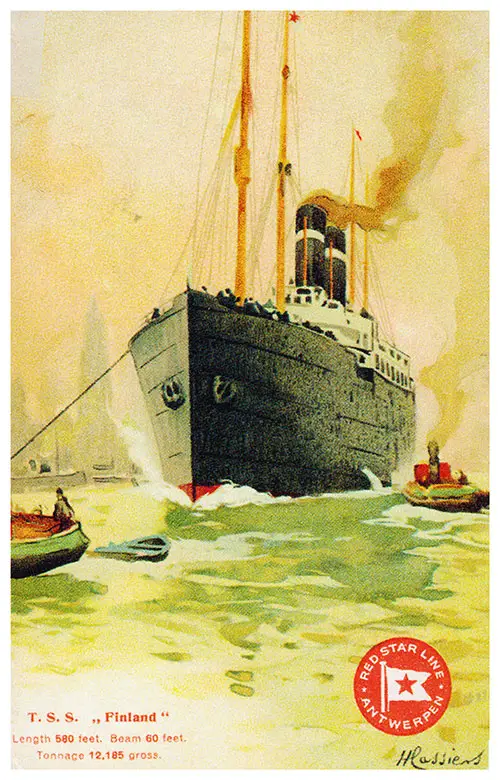
Colorized Postcard of the TSS Finland of the Red Star Line. Length: 580 Feet. Beam: 60 Feet. Tonnage: 12,185 Gross. | GGA Image ID # 1deab19c9d
1912 Summer Olympics and the SS Finland
In 1912, the American Olympic Committee took the U.S. team to the 1912 Summer Olympics in Stockholm, Sweden, on the S.S. Finland.
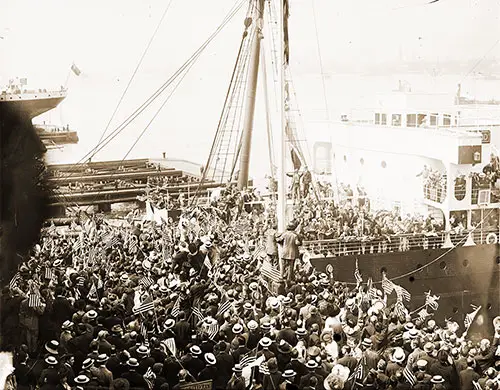
Crowds Gather for the Departure of the Red Star Line SS Finland Transporting the Olympic Team to the 1912 Summer Games in Stockholm, Sweden. Photo by Bain News Service. Library of Congress LCN 2014691992. | GGA Image ID # 1db23675d4
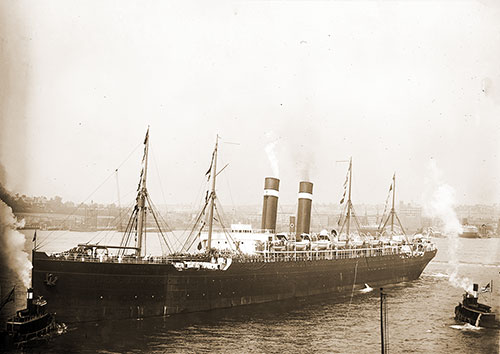
The Red Star Line Ship SS Finland Departed from New York in 1912, Transporting the US Olympic Team to the 1912 Summer Olympic Games in Stockholm, Sweden. Photo by Bain News Service. Library of Congress LCN 2014691989. | GGA Image ID # 1db1bba3e4
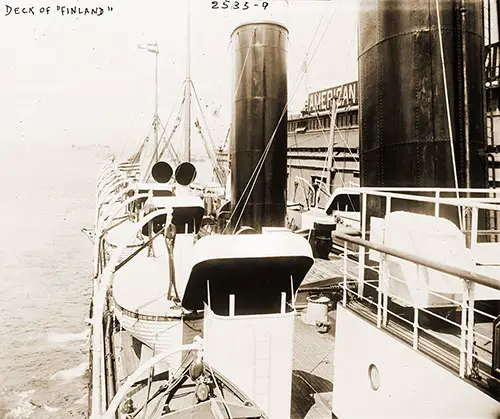
View of the Boat Deck on the SS Finland of the Red Star Line, 1912. Taken during Voyage to Stockholm, Sweden for the Summer Olympics. Photo by Bain News Service. Library of Congress LCN 2014691578. | GGA Image ID # 1db26941a1
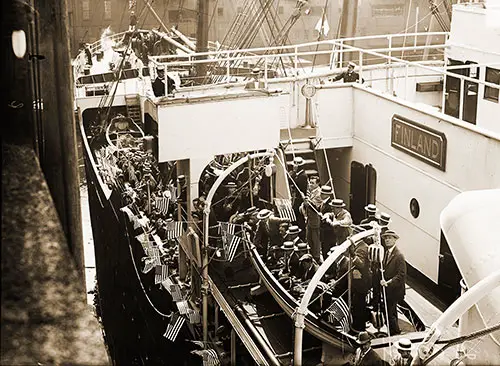
Olympic Athletes on the Decks of the SS Finland During their Voyage to the 1912 Summer Olympics at Stockholm. Photo by Bain News Service. Library of Congress LCN 2014691991. | GGA Image ID # 1db29d09b7
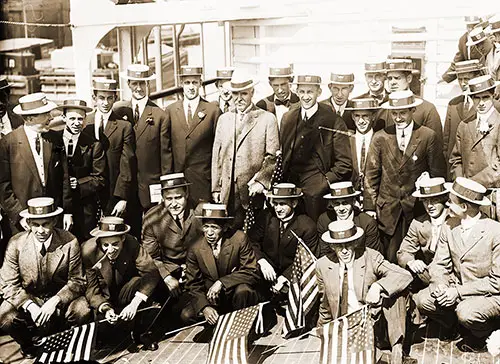
Group Photo of the US Olympic Team Athletes on the Deck of the SS Finland, 1912. Photo by Bain News Service. Library of Congress LCN 2014691990. | GGA Image ID # 1db2ee504d
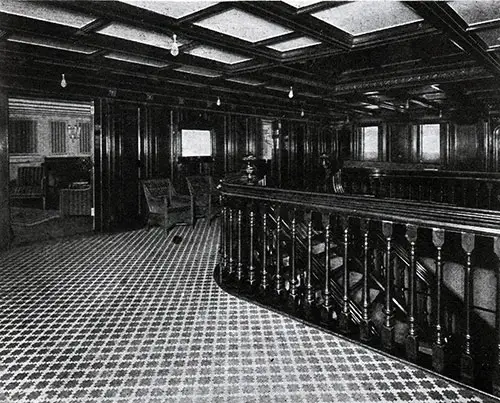
First Class Entrance Hall. Finland, Kroonland, Vaderland, and Zeeland. About Antwerp and the Red Star Line, 1904. | GGA Image ID # 11da4bdf57
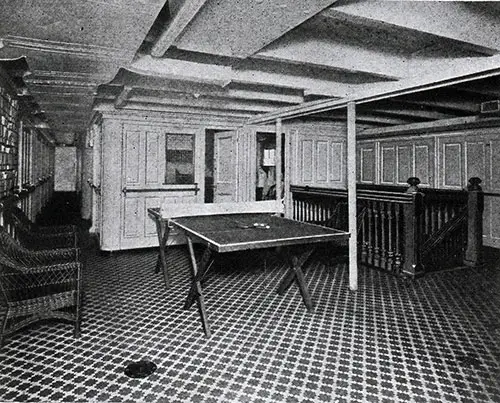
View of the Upper Deck Landing. Finland, Kroonland, Vaderland, and Zeeland. About Antwerp and the Red Star Line, 1904. | GGA Image ID # 11da5547d7
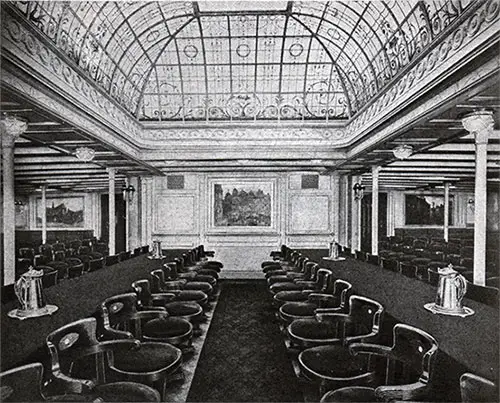
First Class Dining Saloon. Finland, Kroonland, Vaderland, and Zeeland. About Antwerp and the Red Star Line, 1904. | GGA Image ID # 11da5693b9
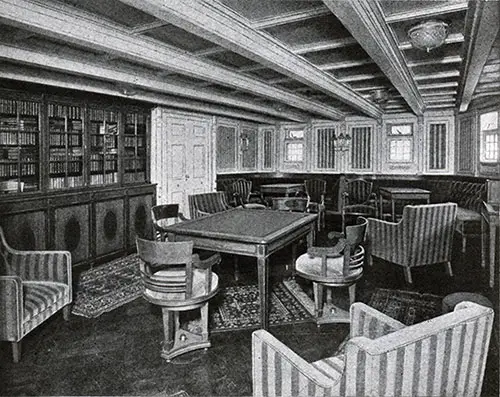
The First Class Library. Finland, Kroonland, Vaderland, and Zeeland. About Antwerp and the Red Star Line, 1904. | GGA Image ID # 11da9a2b48
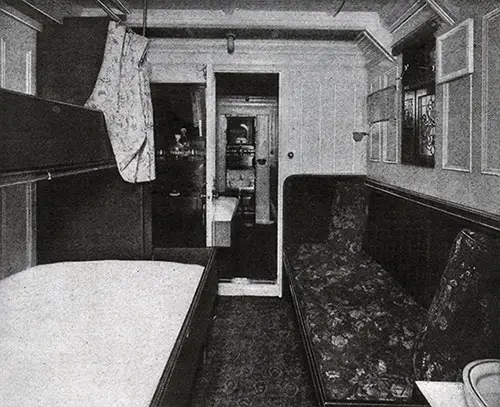
Promenade Deck Suites. Finland, Kroonland, Vaderland, and Zeeland. About Antwerp and the Red Star Line, 1904. | GGA Image ID # 11dab9ea41
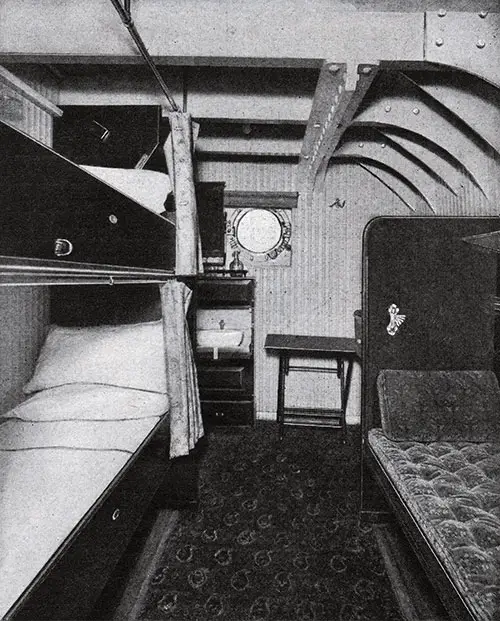
Upper Deck Stateroom. Finland, Kroonland, Vaderland, and Zeeland. About Antwerp and the Red Star Line, 1904. | GGA Image ID # 11daf15fcf
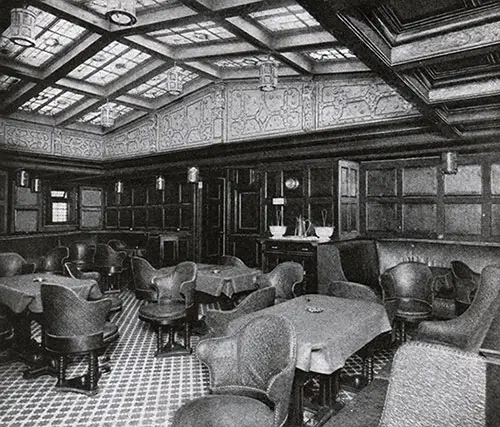
First Class Smoking Room. Finland, Kroonland, Vaderland, and Zeeland. About Antwerp and the Red Star Line, 1904. | GGA Image ID # 11db614d11
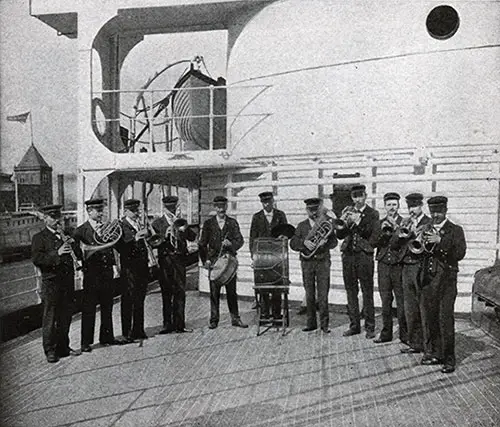
The Typical Ship's Band. Finland, Kroonland, Vaderland, and Zeeland. About Antwerp and the Red Star Line, 1904. | GGA Image ID # 11db7e477e
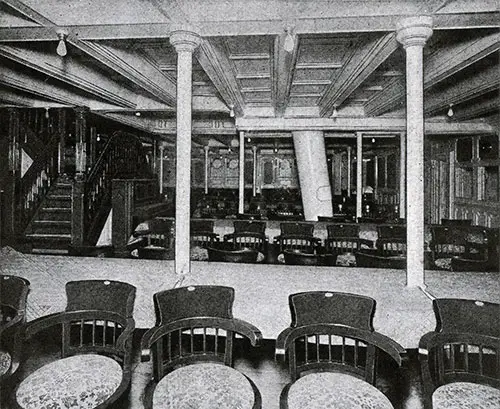
Second Class Dining Saloon. Finland, Kroonland, Vaderland, and Zeeland. About Antwerp and the Red Star Line, 1904. | GGA Image ID # 11dbbc5fdb
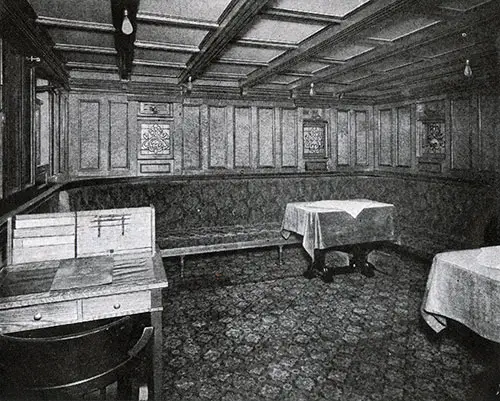
Second Class Ladies' Room. Finland, Kroonland, Vaderland, and Zeeland. About Antwerp and the Red Star Line, 1904. | GGA Image ID # 11dbd04120
Another American Built Steamship for the Red Star Line
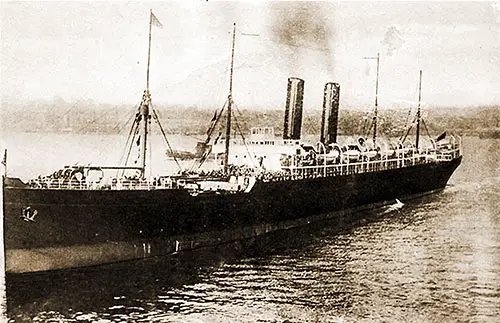
SS Finland of the Red Star Line circa 1902. | GGA Image ID # 1db34409c4
The new twin-screw steamship Finland of the Red Star Line, built at the yards of the William Cramp & Sons Ship and Engine Building Co. in Philadelphia, arrived in New York City Saturday, Sept. 27, 1902.
She will be put into the New York -Antwerp service of the Red Star Line immediately, sailing from New York Saturday, Oct. 4, at 10 A.M. The SS Finland is the last of the quartette of new twin-screw steamships which the International Navigation Company has built for the New York-Antwerp service of the Red Star Line.
She and the Kroonland, recently added to the service, are the largest ships built in the United States. The Finland is built on the same plan as the Vaderland. Still, in the matter of appointments and various conveniences, it is even an improvement over the latter.
The Finland is 580 feet long, 26 feet longer than St. Louis and St. Paul, and has a register of 12,760 tons, or 1,150 tons more than St. Louis and St. Paul. She possesses every device for the safety and comfort of passengers.
She carries the largest improved appliances for the protection of life. Except for the one point of speed, the Finland is equal to the finest steamships afloat. It will enable persons of moderate means to enjoy all the luxuries of the fastest ocean greyhounds.
There are berths for 343 first-class passengers, 194 second-class, and about 1,000 third-class. The arrangement for loading and discharging cargo are complete.
The engines are of quadruple expansion, direct acting, and surface condensing types. The four cylinders each work a separate crank. They are so arranged as to produce a minimum of vibration, the parts being so disposed to be practically balanced without using counterweights on crank arms.
The ship has eight single-ended boilers, constructed of steel and adapted for a working pressure of 200 pounds per square inch, with four furnaces to each boiler, making thirty-two in all.
These boilers are in two compartments, leading into two funnels, which are 98 feet high from the grate level and elliptical in plan, 13 feet 6 inches by 8 feet 6 inches. The eight fans are 7 feet 6 inches in diameter and are installed directly under the funnels.
If the vessel were needed for service in the time of war, the disposition of the bunkers would give coal protection to the boilers. At the same time, safety from breakdowns is assured by adopting twin screws fitted with enclosed shafts and brought close together by adopting a small aperture in the stern frame.
The Finland will be commanded by Capt. F. Albrecht, who was in command of the Vaderland, the first of the Red Star Line's new twin-screw steamships.
"Another American-Built Steamship for the Red Star Line," in Army and Navy Journal: Gazette of the Regular and Volunteer Forces, New York, Vol. XL, No. 5, Whole No. 2041, 4 October 1902, p. 121.
1915 Voyage of the SS Finland
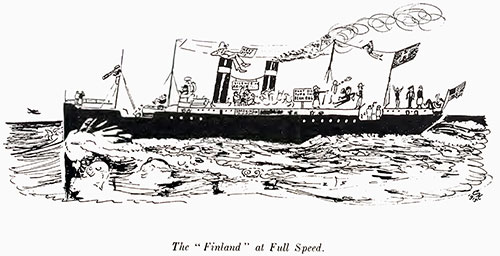
The "Finland" at Full Speed. The Log, 1915. | GGA Image ID # 1db352fbdc
The S.S. "FINLAND" sailed from New York on Saturday, 31 July 1915 (via Panama Canal and San Diego) towards San Francisco.
In the summer of 1915, San Francisco held a double lure for Harvard men — the nineteenth meeting of the Associated Harvard Clubs and the Panama-Pacific Exposition.
Several Harvard graduates in the East, headed by Thomas W. Slocum, with the aid of James A. Wright, secured for Harvard men and their families all the first cabins of the steamer "Finland" of the Panama-Pacific line, bound from New York to San Francisco by way of the Panama Canal.
James A. Wright was a steamship agent whose experience proved of great value. The "Finland" left port with three hundred and ten passengers, of whom two hundred and fifty were in the category of Harvard men, their relatives, and friends. Of these, one hundred and six were Harvard graduates and undergraduates of all ages and classes, from C. W. Clifford down to the youngest recently admitted freshmen.
Total of passage from New York Pier to San Francisco Pier
- Length: 5361 miles.
- Time: 21 Days, 5 hours and 12 min.
Sea passage from Scotland Light Vessel to San Francisco Light Vessel
- Length: 5240 miles.
- Time: 15 Days, 16 hours and 32 min.
- Average speed: 13.92 Knots.
As the voyage progressed, a generous spirit of friendliness spread among the passengers, resulting in enthusiastic cooperation toward the important end of having a good time.
Finland torpedoed - 1921
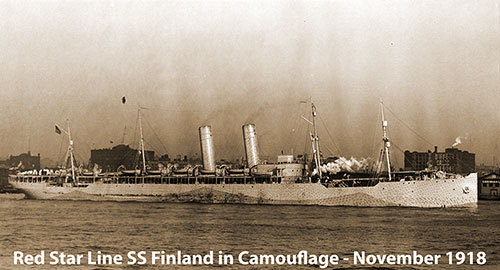
SS Finland of the Red Star Line in Camouflage, November 1918. Photo by International Mercantile Marine, New York. In April 1917, the Liner Was Chartered by the United States Army and Made Five Transatlantic Runs Ferrying Troops to Europe. U-93 torpedoed SS Finland on Her Third Voyage and, in April 1918, Was Transferred to the U.S. Navy and Commissioned as "Uss Finland." She Returned over 32,000 Troops to the United States Before Being Decommissioned in September 1919 and Returned to International Mercantile Marine and Resumed Her Original Name of Ss Finland. | GGA Image ID # 1db0d6a3c5
The Transport SS Finland arrived in France on October 7th in the same convoy as the ill-fated SS Antilles. It sailed again for the United States in the early morning of October 28th in company with SS Buford and SS City of Savannah cargo vessels. The escort consisted of the armed yachts SS Alcedo, SS Corsair, and SS Wakiva, and the destroyers USS Smith, USS Lamson, USS Preston, and USS Flusser. The speed of the convoy was eleven knots. Commander S. V. Graham, U. S. Navy, was the senior Naval Officer on the SS Finland.
At 9:27 of the same morning of departure, while in Latitude 46° 49' North, Longitude 6° 21' West, a torpedo fired at the SS Finland was sighted about thirty degrees abaft the starboard beam at a distance of about 200 yards. A few seconds later, it struck the starboard side under the bridge before the ship could be maneuvered to avoid it.
Civilian crews manned both the SS Finland and the SS Antilles, the Naval personnel on board being additional to safeguard the ship against the enemy and to take charge in an emergency. The SS Finland was carrying home the survivors of the SS Antilles. Most of these merchant sailors were foreigners of all nationalities, the sweepings of the docks, shipped just before sailing from New York for one voyage only. The terror from which the men of the Atetilles had not yet recovered had been communicated by their stories to the crew of the SS Finland, which was made up of the same type of men.
The result was that when the torpedo struck the ship, both the SS Finland crew and the SS Antilles survivors rushed to the boats and began lowering them. Some boats were in the water, and some capsized before the Naval and ship's officers gained control of the situation.
At the same time, the engine room and fire room crews left their stations and rushed on deck, which was contrary to orders. These men were finally driven below with a revolver and a heavy wooden mallet, and the engineers' stations were again crewed.
As the ship began to list heavily to starboard, the other boats were lowered in a more orderly manner, with the passengers and some of the crew in them.
The damage was found confined to one of the cargo holds, which was flooded; the engine room and fire room compartments were intact. The ship's list stayed the same, and Graham decided that the ship would remain afloat and that she could be worked under her own steam.
Many men drifting about in the boats were taken on board and the remainder left to be picked up by the SS Wakiva and SS Alcedo, who were standing by and rescuing men in the water. At 10:45, the SS Finland shaped a course for Brest and anchored in the harbor the following morning.
As a result of this experience with the ignorant and unreliable men composing the crew of the SS Finland, the Court of Inquiry which investigated the circumstances recommended that all troop transports be officered and manned entirely by Navy personnel. This reinforced the recommendations I had previously made and was done as rapidly as possible.
Vice Admiral Albert Gleaves, USN, "Finland Torpedoed," A History of the Transport Service: Adventures and Experiences of United States Transports and Cruisers in the [First] World War, New York: George H. Doran Company, 1921:108-110.
Return to Content Links
